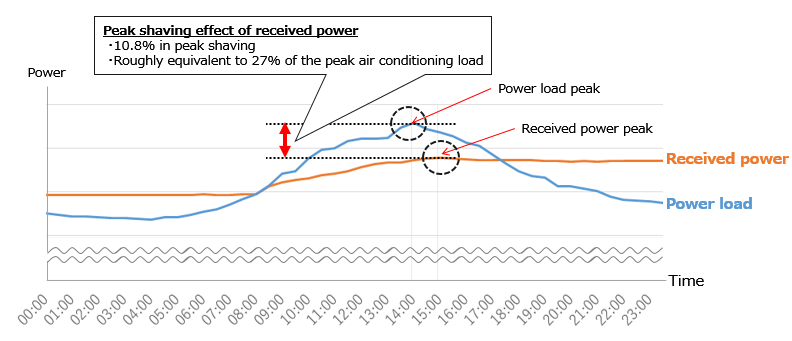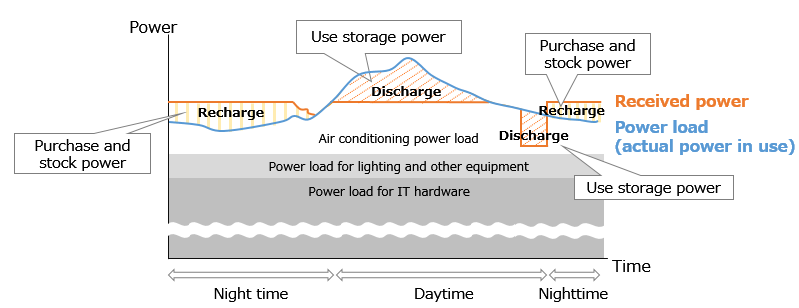Top of Page
- Links to move inside this page.
- HOME
- About IIJ
- News / CSR
- Press Releases
- 2020
- Electricity Control Validation Results for the Shiroi Data Center
Electricity Control Validation Results for the Shiroi Data Center
Verifying the effects of peak shaving and load shifting using Tesla’s industrial lithium-ion batteries
December 17, 2020
TOKYO-December 17, 2020-Internet Initiative Japan Inc. (IIJ, TSE1: 3774), one of Japan's leading Internet access and comprehensive network solutions providers, today announced that it conducted tests to validate the Tesla industrial lithium-ion batteries known as Powerpack. In November 2019, IIJ installed the Powerpack system, with their operation control function, in its Shiroi Data Center Campus (Shiroi DCC; located in Shiroi-city, Chiba Prefecture) to level the power consumption of its summertime air conditioning. Since introducing the batteries, IIJ has been testing their peak shaving and load shifting (*1) performance. As a result, in August-the annual peak period-it measured a peak shaving effect of 10.8% of the total Shiroi DCC power demand.
- (*1) Peak shaving: Reducing power demand during peak hours, during which the most energy is used.
Load shifting: Shifting the power demand from peak hours to times of low energy usage (including the middle of the night).
Objective and reason for the verification
Recently, there has been a greater demand for initiatives to realize a low-carbon society. The Act on the Rational Use of Energy (Japanese Energy Conservation Law) also requires specified businesses to "strive to promote the leveling of electricity demand." As an infrastructure service provider, IIJ has built and operated data centers with outstanding environmental performance. IIJ has optimized the Shiroi DCC’s energy efficiency by implementing the latest energy-saving technologies, including highly energy-efficient outside-air cooled and AI-controlled air conditioning. However, outside-air cooling is not possible during the summer, and leveling power demand (load) is difficult due to peak energy usage occurring during the day. That is why IIJ decided to use lithium-ion batteries with energy management functions to level electricity demand by charging electricity at night and discharging the stored electricity during peak daytime hours to ensure peak shaving.
Verification details
Tesla Powerpack system, which have a storage battery operation control function, are loaded with electricity demand data based on past usage, and they calculate electricity forecast data through machine learning iterations based on daily operation. The data is checked against electricity prices, and the system is set to charge and discharge according to energy unit prices. IIJ assessed and verified whether peak shaving and load shifting could be achieved by automatically controlling the charging/discharging timing of the storage battery based on the learning results in response to fluctuations in the power demands of the operating data center.
Results from the verification using measured data in August 2020
- Measured a peak shaving effect of 10.8% of data center power demand (on peak electricity usage day during summer)(*2)(Figure 1)
- Confirmed that load shifting follows predictions of automatically controlled recharge and discharge cycles based on the electricity utility's unit prices that are set by the time of day(Figure 2)
- Verified that electricity costs were cut due to the above peak shaving and load shifting effects(*3)
- (*2)When applying all the peak-shaved electricity to that for the air conditioning load, the figure is roughly equivalent to 27% of the peak air conditioning load.
- (*3)Basic electricity charges are calculated based on consumers’ maximum power demand (peak power), so basic charges can be curbed by lowering the maximum power demand. Moreover, load shifting makes it possible to purchase electricity at low nighttime unit prices and to use it during the day, thereby reducing electricity charges.
- (*)These results were measured with the current configuration of load power and storage batteries. Since the load power is still small compared to the storage battery capacity, the measured results indicate a larger reduction than the target value (15% reduction in peak power for air conditioning).
Figure 1: Annual Peak Day Power Usage (From a typical day in August 2020)

Figure 2: Electricity Use in Light of Electricity Rates by Time of Day

When controlling Internet traffic, packets have to be discarded when the line capacity overflows. However, electricity can be temporarily stored in storage batteries, so controlling the flow of electricity means that storage batteries can effectively act as a backup for the power grid. This verified system of leveling power through peak shaving will make it possible for data centers, which consume large amounts of energy from the power grid, to function not only as data storage facilities but also as power storage facilities. The system should play a role in contributing to power supply-and-demand adjustments and to the increasing use of renewable energy worldwide.
As the growth of IT facilities raises the demand for electric power, the Shiroi DCC will continue its energy control verification and conservation efforts, drive network infrastructure evolution through technological innovation, and help solve various social issues.
Reference
- Press release dated October 21, 2019 "IIJ to Deploy Tesla Powerpack at Shiroi Data Center Campus"
https://www.iij.ad.jp/en/news/pressrelease/2019/1021.html
About IIJ
Founded in 1992, IIJ is one of Japan's leading Internet-access and comprehensive network solutions providers. IIJ and its group companies provide total network solutions that mainly cater to high-end corporate customers. IIJ's services include high-quality Internet connectivity services, systems integration, cloud computing services, security services and mobile services. Moreover, IIJ has built one of the largest Internet backbone networks in Japan that is connected to the United States, the United Kingdom and Asia. IIJ was listed on the First Section of the Tokyo Stock Exchange in 2006.
- For more information about IIJ, visit the IIJ Web site at https://www.iij.ad.jp/en/.
The statements within this release contain forward-looking statements about our future plans that involve risk and uncertainty. These statements may differ materially from actual future events or results.
- For inquiries, contact
-
IIJ Corporate Communications
 +81-3-5205-6310
+81-3-5205-6310  +81-3-5205-6377
+81-3-5205-6377  press@iij.ad.jp
press@iij.ad.jp
- (*)All company, product, and service names used in this press release are the trademarks or registered trademarks of their respective owners.
- Related Contents
End of the page.